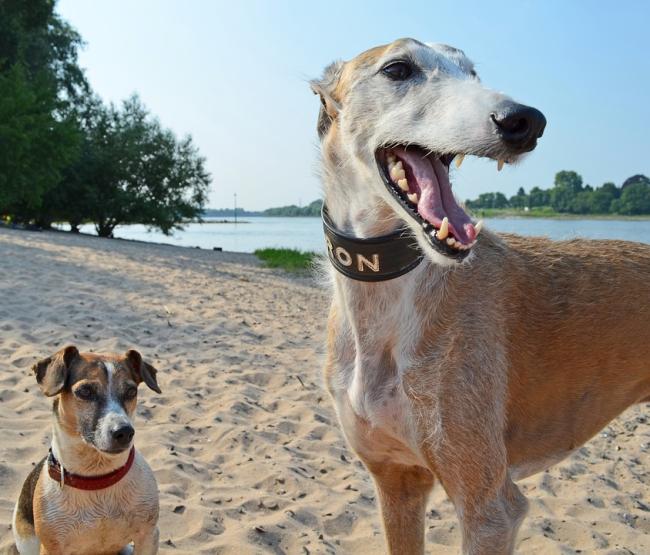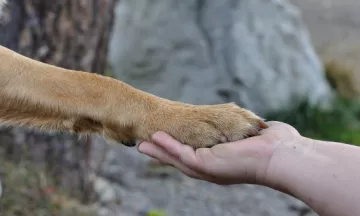Mind the body language: how to introduce dogs safely
Anyone who owns a dog knows how exciting it can be to meet another dog. It's important to pay close attention to the body language of the dogs and to ensure that the meeting is calm and friendly. Also, if you're a dog sitter and you want to add a new dog to your 'pack' during home boarding, it is crucial that the first meeting is a nice experience for both dogs. But how do you introduce dogs to each other in a safe and fun way?
For your dog, it can be great for them to get to know other dogs. But these new encounters can be quite complicated. And every owner has their own ideas: 'Just let them go ahead and sort out their difference'. Or: 'my dog doesn't mean any harm, they just want to play!'. But what really is the best way to introduce dogs safely? With these 5 tips, you will ensure a safe and fun first meeting between two dogs.
1) On-leash or off-leash?
There are different opinions about whether you should introduce two dogs on a leash or not. It is true that off-leash dogs feel freer and can move around more easily. They can decide for themselves how and how fast they approach the other dog. Most of the time, encounters in off-leash areas run smoothly.
But still, there are some very good reasons to keep leash a dog when meeting a new dog. The other dog may be leashed because of an injury or condition, because he or she is anxious, or has a tendency to run away.
In any case, put the leash on as soon as you see another leashed dog as problems often arise when one dog is on-leash and the other is not. Give the other dog plenty of space and make sure you keep your dog's leash loose. Don't force the dogs to do anything they don't want to, and let them take the initiative to approach each other.

2) Space, space, space!
Dogs that meet each other for the first time often are very reluctant, polite and shy. When we humans meet someone new, we tend to walk straight towards each other and make eye contact. For dogs, it's very different. They want to express non-threatening signals and therefore they tend to walk around each other in a circle instead of a direct approach.
Before dogs start to smell each other, they want to check out who they're dealing with from a distance. They keep enough space around them so they can walk away at any time if the meeting goes wrong. So step aside and give the dogs the time and to explore each other without any pressure. Do you notice another dog (or your own dog) really avoiding an unfamiliar encounter? Then avoid the confrontation and walk away.
Here's some more information about dog dominance and the idea of a dog wanting to be the 'boss' when meeting a new dog.
3) Mind the body language
Once the dogs have spotted each other, they will let each other know if they are open to contact. Always pay attention to the subtle signals of each dog's body language. While it may seem as if the dogs are not interested, in reality, they might have a whole 'conversation' with each other.
Observe your own dog closely in every situation: you will understand the body language of your dog more, which will also increase the bond between you and your dog.
Also - pay attention to your own posture and body language: as soon as you see another dog approaching, breathe, relax and talk positively about that other dog. By doing this, you will influence your own mood and create a positive atmosphere, which makes the introduction less stressful.
Here's a rundown on doggy body language...
When an introduction is going well, you might observe:
- Looking away: 'I don't want to cause trouble!'
- Calmly walking around each other in a circle
- First sniffing each other under the tail
- Relaxed wagging tails at medium height
- Shoulders down, butt in the air: 'I want to play with you!'
- The dogs respecting each other's little corrections and giving each other plenty of space.
When a meeting isn't going well, be careful. You might observe:
- Staring and stiffening the body, tail straight up
- Growling, showing teeth
- Yawning, licking lips
- Neck hairs up
- Tail between the legs, anxious, squeaking
- One dog ignores the other dog's corrections and continues when the other doesn't. Separate them if so.

4) Intervention: be calm and firm
Do you pick up on a warning signal from one of the dogs? Stop the meeting. You can do this by stepping away from the dogs, firmly calling your dog and walking away from the situation. Of course, praise your dog if he or she listens to and obeys you.
In case of an unfriendly or even a hostile meeting, always try to remain calm. Yelling and raising your voice only stirs aggression and excitement. Do not physically push or pull your dog, but instead try to calmly distract your dog with your voice. Make sure you have a few treats in your pocket with which you can attract your dog's attention.
5) Respect each other
Maybe you have a very enthusiastic dog that is super happy to play with other dogs. But every dog is different. Some of them may be afraid due to past trauma. Others may have an injury, are in a training program or have another reason why they can't or won't meet other dogs.
Therefore, don't just look at the body language of dogs, but also of their human owners. Because a dog's owner knows best. Respect each other's boundaries! Check out this blog on more about dog etiquette.
Adding a new dog to your pack
Are you a dog sitter offering home dog boarding or doggy daycare for multiple dogs? Or maybe you already have a dog yourself and you want to introduce a new dog to your home? Make sure that the first encounter with the new dog is always on neutral territory: meet each other outside in a dog park, for example. Walking together is a safe and non-aggressive way to introduce dogs to each other. Every dog loves to walk, and doing it together will encourage bonding and a positive pack atmosphere.
Do you want some tips to walk several dogs at once? Here is how!
Does your dog love to meet new people and dogs? You can find a loving Pawshake dog sitter that offers personalized care for your dog. This is a great way to help socialise your furry friend with new pets and people in a positive and rewarding way.





